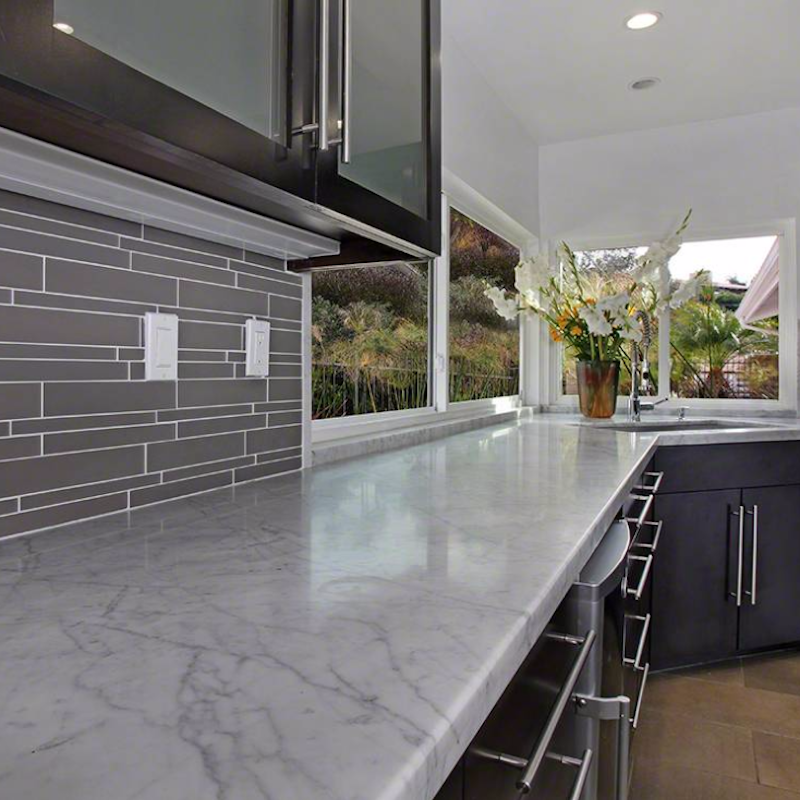Marble Countertops For High Traffic Areas
March 11, 2013
White marble is undeniably one of the most recognizable and elegant natural stones available for countertops today. Marble stone buyers are typically drawn to the high end, discerning look that is a marble countertop, valuing its smooth, clean look for a bathroom vanity, wet bar, or kitchen countertop. A white marble slab over deep dark wooden cabinets is an Old World look that began with the kitchens and coffee houses of Italy.
It was made even more popular in the U.S. by Martha Stewart centuries later, when she invited viewers into her home to see her work dough and pastries on cool, white cararra countertops. The fresh look of white marble accentuated by a vase of colorful purple peonies, a basket of brown eggs, or a bowl of colorful fruit inspired an explosion of photo shoots and a burning desire by homeowners to mimic Martha’s style in their own homes.
The look of marble slabs, with their striking veins against gorgeous white backdrops, are one reason why people want it. It is the epitome of luxury, for those wanting ‘the best’, and yet it is surprisingly one of the most affordable natural stones, another reason people want it. So why doesn’t everyone have marble countertops in their bathrooms and kitchens?
Marble is known to be a more porous, softer stone than some of its natural stone counterparts. Its nature lends itself to staining and etching more easily. Some buyers are undaunted by the possibilities of chips or stains, however, as they feel the patina adds to the character of their kitchen or enjoy the process of ageing natural materials. Others, however, desire a more modern design aesthetic that necessitates a less “lived in” look for their countertops. With proper choices, care and maintenance, marble countertops can certainly satisfy this second group.
Before we discuss a few tips to keeping marble countertops looking new, we offer a clarification on the term “etching”. Permanent etching would be the result, for example, of placing an acidic lemon face down on a marble surface for a period of time. When removed, the result would be a clear mark that is less shiny than the rest of the surface, likely permanent. Temporary etching would be more like what happens when the stone gets wet from water. The affected portion would appear darker until the water soaks in or dries, with no lasting change to the stone itself (common to many natural stones that are not sealed). For the purposes of the tips below, we’re referring to permanent etching, a result acceptable to those embracing an Old World patina and a result less desirable to those with a modern look in mind.
- Honed marble countertops are a usually a better choice than highly polished marble slabs if the look of etching is not desirable. Permanent etching is less noticeable on a more matte surface.
- All spilled liquids and spices should be wiped immediately from the surface. Red or purple liquids will stain more obviously and should be taken care of with greater urgency. Red wine, beets, turmeric, mustard, oil, and blood are examples of items that should not be allowed to sit on marble.
- New marble buyers are encouraged to retain an unused piece of their marble to test its limits. Leftover pieces from the install, such as remnants from cutting the holes for sinks and faucets, are ideal for this purpose. Use them to experiment with liquids, spices, and knives to get a sense of what your particular countertop can endure. Knowing a red wine drip needs to be swiped up within 5 minutes but a few drops of beef broth can sit for hours on a particular marble is invaluable information down the road to owners who wish to delay ageing.
- There are products designed for polishing marble countertops. Stains can often be removed with these polishes. Keep them handy for spot removal, as the quicker a polish is used, the more likely it will combat staining. Over time, some stains will also fade on their own or become lighter and less noticeable.
- It is true that marble is a “softer” stone. However, it is still stone. It can usually endure more than owners think. Take care in high traffic areas, such as around the sink or landing spots for pots and pans, but keep in mind that the softness of the stone does have an advantage. Marble can be re-honed or polished to treat etching, scratches or stains. Harder surfaces do not offer this option.
- The key to keeping marble looking beautiful is to seal it. Though it can be professionally done, sealing is an easy do-it-yourself project with a wipe-on sealant. Well-sealed marble will ensure liquids bead on the countertop and do not sink in. How often sealing is needed will vary depending on the type of sealant used in the past. When water does not bead on the surface, it is a good indicator that it is time to reseal.
 Featured: Carrara White Marble
Featured: Carrara White Marble
Marble countertops are classic. Timeless. They offer a bright, stunning white unrivaled by other natural stones. Best of all, marbles come in a variety of colors from Carrara White Marble to the darkest China Black, and are elegant, affordable options for natural stone lovers. Whether a buyer desires an aged look, etches and all, or a sleeker surface, marble can meet the needs of most, even in high traffic areas.
MSI is the leading importer and distributor of countertop products in North America, offering more than 50 marble color options and patterns to choose from. For more about marble and marble care, visit The Marble Institute of America or The Natural Stone Institute on the web.

